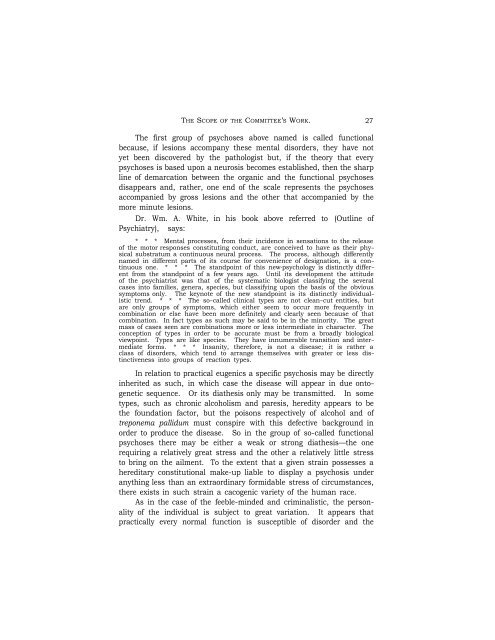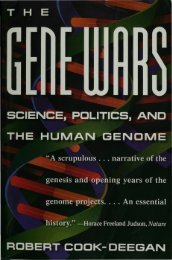Eugenics Record Office. BULLETIN No. 10A - DNA Patent Database ...
Eugenics Record Office. BULLETIN No. 10A - DNA Patent Database ...
Eugenics Record Office. BULLETIN No. 10A - DNA Patent Database ...
Create successful ePaper yourself
Turn your PDF publications into a flip-book with our unique Google optimized e-Paper software.
THE SCOPE OF THE COMMITTEE’S WORK. 27<br />
The first group of psychoses above named is called functional<br />
because, if lesions accompany these mental disorders, they have not<br />
yet been discovered by the pathologist but, if the theory that every<br />
psychoses is based upon a neurosis becomes established, then the sharp<br />
line of demarcation between the organic and the functional psychoses<br />
disappears and, rather, one end of the scale represents the psychoses<br />
accompanied by gross lesions and the other that accompanied by the<br />
more minute lesions.<br />
Dr. Wm. A. White, in his book above referred to (Outline of<br />
Psychiatry), says:<br />
* * * Mental processes, from their incidence in sensations to the release<br />
of the motor responses constituting conduct, are conceived to have as their phy-<br />
sical substratum a continuous neural process. The process, although differently<br />
named in different parts of its course for convenience of designation, is a con-<br />
tinuous one. * * * The standpoint of this new-psychology is distinctly differ-<br />
ent from the standpoint of a few years ago. Until its development the attitude<br />
of the psychiatrist was that of the systematic biologist classifying the several<br />
cases into families, genera, species, but classifying upon the basis of the obvious<br />
symptoms only. The keynote of the new standpoint is its distinctly individual-<br />
istic trend. * * * The so-called clinical types are not clean-cut entities, but<br />
are only groups of symptoms, which either seem to occur more frequently in<br />
combination or else have been more definitely and clearly seen because of that<br />
combination. In fact types as such may be said to be in the minority. The great<br />
mass of cases seen are combinations more or less intermediate in character. The<br />
conception of types in order to be accurate must be from a broadly biological<br />
viewpoint. Types are like species. They have innumerable transition and inter-<br />
mediate forms. * * * Insanity, therefore, is not a disease; it is rather a<br />
class of disorders, which tend to arrange themselves with greater or less dis-<br />
tinctiveness into groups of reaction types.<br />
In relation to practical eugenics a specific psychosis may be directly<br />
inherited as such, in which case the disease will appear in due onto-<br />
genetic sequence. Or its diathesis only may be transmitted. In some<br />
types, such as chronic alcoholism and paresis, heredity appears to be<br />
the foundation factor, but the poisons respectively of alcohol and of<br />
treponema pallidum must conspire with this defective background in<br />
order to produce the disease. So in the group of so-called functional<br />
psychoses there may be either a weak or strong diathesis—the one<br />
requiring a relatively great stress and the other a relatively little stress<br />
to bring on the ailment. To the extent that a given strain possesses a<br />
hereditary constitutional make-up liable to display a psychosis under<br />
anything less than an extraordinary formidable stress of circumstances,<br />
there exists in such strain a cacogenic variety of the human race.<br />
As in the case of the feeble-minded and criminalistic, the person-<br />
ality of the individual is subject to great variation. It appears that<br />
practically every normal function is susceptible of disorder and the



